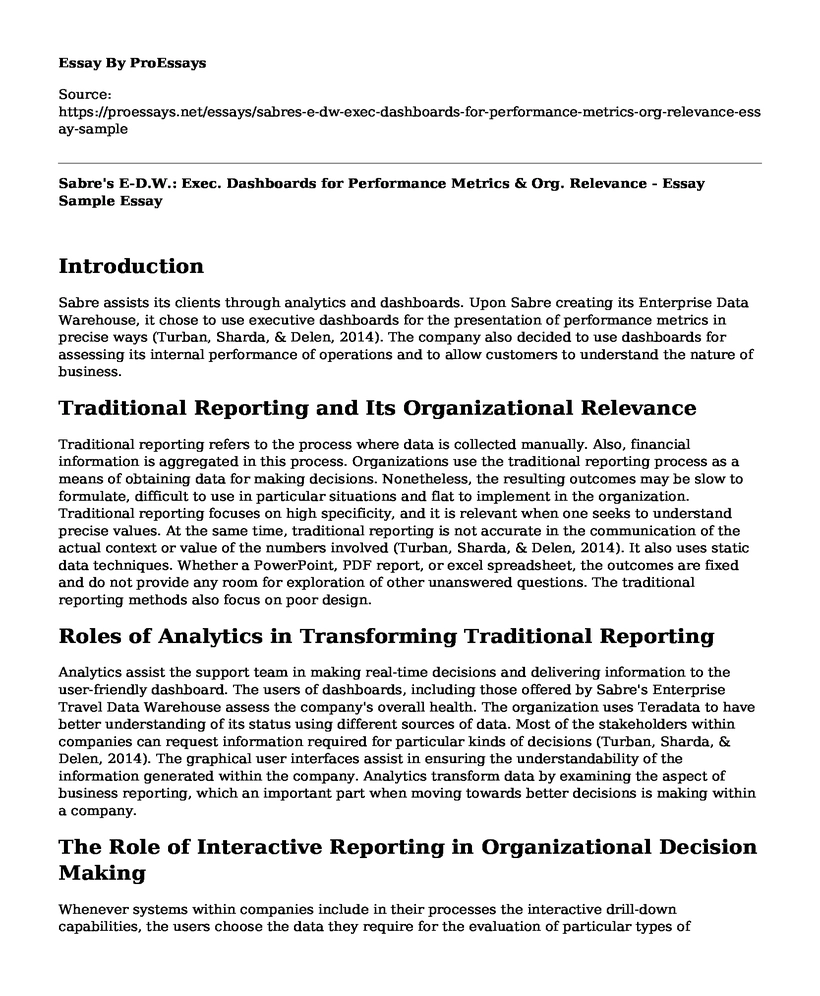Introduction
Sabre assists its clients through analytics and dashboards. Upon Sabre creating its Enterprise Data Warehouse, it chose to use executive dashboards for the presentation of performance metrics in precise ways (Turban, Sharda, & Delen, 2014). The company also decided to use dashboards for assessing its internal performance of operations and to allow customers to understand the nature of business.
Traditional Reporting and Its Organizational Relevance
Traditional reporting refers to the process where data is collected manually. Also, financial information is aggregated in this process. Organizations use the traditional reporting process as a means of obtaining data for making decisions. Nonetheless, the resulting outcomes may be slow to formulate, difficult to use in particular situations and flat to implement in the organization. Traditional reporting focuses on high specificity, and it is relevant when one seeks to understand precise values. At the same time, traditional reporting is not accurate in the communication of the actual context or value of the numbers involved (Turban, Sharda, & Delen, 2014). It also uses static data techniques. Whether a PowerPoint, PDF report, or excel spreadsheet, the outcomes are fixed and do not provide any room for exploration of other unanswered questions. The traditional reporting methods also focus on poor design.
Roles of Analytics in Transforming Traditional Reporting
Analytics assist the support team in making real-time decisions and delivering information to the user-friendly dashboard. The users of dashboards, including those offered by Sabre's Enterprise Travel Data Warehouse assess the company's overall health. The organization uses Teradata to have better understanding of its status using different sources of data. Most of the stakeholders within companies can request information required for particular kinds of decisions (Turban, Sharda, & Delen, 2014). The graphical user interfaces assist in ensuring the understandability of the information generated within the company. Analytics transform data by examining the aspect of business reporting, which an important part when moving towards better decisions is making within a company.
The Role of Interactive Reporting in Organizational Decision Making
Whenever systems within companies include in their processes the interactive drill-down capabilities, the users choose the data they require for the evaluation of particular types of performances. The users are also allowed to make decisions in a specific situation or function. For instance, the airlines utilizing the Sabre System have the privilege of focusing on data concerning performances of sales (Turban, Sharda, & Delen, 2014). These data cover information such as tickets sold and the seats used by passengers. The Sabre System can also focus on data about performances of operations such as inventory and the movement of flights. This type of flexibility ensures the decision-makers within a company use data in supporting their decisions.
Conclusion
Analytics is the technology driver in this era, with companies such as Oracle, IBM, and Microsoft, among others adopting the same. These organizations have created new units that use analytics to improve business processes, ensuring effectiveness and efficiency in operations. The decision-makers are utilizing more computerized tools in making their decisions. Consumers are also using analytics tools indirectly or directly to make decisions about routine tasks such as entertainment, healthcare, and shopping. As shown, Organizations use the traditional reporting process as a means of obtaining data for making decisions. The users of dashboards, including those offered by Sabre's Enterprise Travel Data Warehouse assess the company's overall health. Using interactive reporting, the company achieves flexibility, which ensures the decision-makers within a company use data in supporting their decisions.
References
Turban, E., Sharda, R., & Delen, D. (2014). Business intelligence and analytics: systems for decision support. Pearson Higher Ed. Retrieved from http://seu1.org/files/level8/IT445/IT445%20BOOK%20EDIT.pdf
Cite this page
Sabre's E-D.W.: Exec. Dashboards for Performance Metrics & Org. Relevance - Essay Sample. (2023, Feb 23). Retrieved from https://proessays.net/essays/sabres-e-dw-exec-dashboards-for-performance-metrics-org-relevance-essay-sample
If you are the original author of this essay and no longer wish to have it published on the ProEssays website, please click below to request its removal:
- Manipulation Tactics and Consumer Behavior: Creating a Desire to Purchase Paper Example
- Environmental Scan for Starbucks Company - Essay Sample
- Paper Example on Marketing Audit: Apple Co. SWOT & PESTLE Analysis
- Essay Sample on Online Marketing: Utilizing Social Media to Reach Global Audience
- Essay on Amazon.com: 1994-750000 Employees, E-Commerce Success & Global Expansion
- Successful Org Design: CDS Achieves Goals With Strategy, Ops, HR & Leadership - Essay Sample
- Walmart Leverages Global Supply Chain Strategies for Global Reach Essay Example







